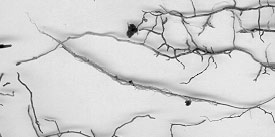With one mouse click you can digitize and analyse roots ! |
| 1. ROOT POSITIONING |
Simply place the roots directly on the scanner glass or in Regent’s water-proof
trays. Root positioning is easy and fast with Regent’s positioning system for optical scanners (see
below). Roots can reasonably overlap and do not need to be randomly distributed. |
| 2. ACQUIRE THE IMAGE |
Click the scanner icon to digitize the roots and wait a few seconds for the scan to
complete and the image to appear on screen. There is no need to use another program to digitize the images,
WinRHIZO controls the scanner directly. It can also analyse images stored
in files (tiff, jpeg, png, jpeg2000 or bmp). |
|
|
| 3. ANALYSE THE ROOTS |
A few seconds later, the analysis is complete and roots found by WinRHIZO are identified by colored lines in the image. The colors used for drawing them are coded according to the root diameter. Some analyses (Nodules counting, Color and Topology for example) require interactions from the operator before proceeding.
Root length and diameter are measured with Regent’s unique method** and with Tennant’s statistical method. With the former, measurements are made continuously at each point along the root. Root overlap at forks and tips are taken into account to provide accurate measurements of length and area. Some measurements made by the system can be overridden by the operator. |
| 4. SAVE THE MEASUREMENTS DATA |
The last step of the analysis is data saving. WinRHIZO knows when data are ready to be saved and does this automatically. Data files are in ASCII (text) format easily readable by many programs including spreadsheets like Excel. Images and their analyses can also be saved to files for later validations, reanalyzes or visualization in other software programs. |
|
| |
Roots can be measured automatically by WinRHIZO when they are extracted from soil and washed of debris. Before analysis, they must first be digitized with a scanner or camera.
WinRHIZO standard systems uses a desktop optical scanner as the image acquisition device. They are well adapted to image acquisition of macroscopic objects like roots or leaves. Regent’s scanners come with:
- Accessories to accelerate root positioning and scanning,
- A special lighting system to avoid shadows (see below),
- A permanent calibration to increase the measurements precision,
- An instruction manual and video that explain how to scan biological samples
(root, leaves, seeds...) for analysis with our programs (scanning for
scientific analysis is different than for artistic applications). It also
gives tips specific to the scanner purchased (such as scanning speed
vs. quality issues).
Regent’s scanners can also be used for other applications (documents or photos scanning). They are currently available in two scan area sizes (to view our current models click here). |
|
Our positioning systems significantly increase your productivity. It is made of plastic blocks that can be installed and removed quickly to accommodate different scan area sizes. Together they form a semi-opaque area with a hole (the scanned area) for samples positioning. Trays that match these rectangular scan areas are supplied with a complete system. |
|
|
|
How does it increases the productivity?
- You don’t have to worry where to place the samples on the scanner glass. Once you have determined the sample positioning scheme, you simply insert the samples in the open area on the glass for the acquisition of subsequent images. The WinRHIZO program has pre-defined positioning options for you to choose from.
- Because WinRHIZO knows the size and position of the sample on the scanner glass, you can bypass the traditional scanner Preview step. You save 20 to 30 seconds for each scan. That’s a lot of time after thousands of scans!
- While a sample is being scanned or analysed, you (or a second operator) can prepare the next root sample in another tray away from the scanner.
|
|
Why an additional lighting system?
Without a good image of the roots, an unnecessary complex and lengthy
root detection algorithm is required. Root image acquisition with an optical scanner without proper attention to the lighting
system, might produce artifacts that make roots identification tedious and imprecise. Shadows (below) is one example. |
Shadows have grey levels close to those of the roots. Determining the position of the root boundary is much more difficult when they are present. |
 |
REFERENCES
* “WinRHIZO™, a root-measuring system with a unique overlap correction method”, Arsenault, J.-L., S. Pouleur, C. Messier, and R. Guay. 1995. HortScience 30: 906. (Abstract).
** “Accuracy of Measurements with Mac/WinRHIZO™”. Stephan Pouleur, REGENT INSTRUMENTS Technical note #3, 1995, pp. 1-4.
*** “A test of a modified line intersect method for estimating root length”. Tennant D. 1975, J. Ecol. 63. pp. 995-1001. |
|
